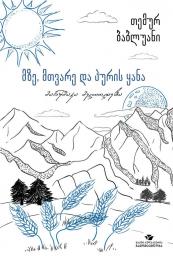THE SUN, THE MOON AND THE WHEAT FIELD
BABLUANI TEMUR
The main appeal of Temur Babluani’s novel lies in its numerous adventures, a rich gallery of characters and an array of unbelievable escapades that feature the protagonist Jude Andronikashvili, often an unintentional centre of the entire plot. The story begins in the 1960s and continues to our times, making it an epic narrative, a kind of an odyssey taking a seemingly ordinary Georgian teenager across the Soviet Union, throwing him into perilous situations many a time only to return him home relatively safe and sound.
Temur Babluani’s prose is highly cinematographic, especially evident in the near photographic descriptions of the ugly reality hidden behind the sham facade of the Soviet well-being. We are left with the impression that the characters of the novel gradually open up, reveal their true nature as well as that of the era which ended long ago but still has tangible influence on our lives. The 500-page novel is a real page-turner for readers of all ages: on practically every other page new characters appear, the plot takes a new twist, compelling us to read on, realistic narratives are alternated by mystical, detective or romantic stories. Although the plot takes us from one Soviet country to another, from the icy Siberia to the sunny Black Sea, from prisons and gulags to psychiatric wards, the protagonist never gives up his hope to return home where Manushaka waits for him, the only person in the world who he loves dearly since his childhood.
‘I am pleased that there is a tendency in Georgian literature to turn away from the mainstream and experiment with new texts. The reader will find a good, interesting and non-trivial book. We didn't have this kind of adventure literature before.
Z. Andronikashvili, literary critic
In case of using the information, please, indicate the source.
